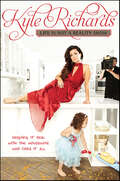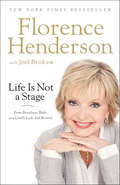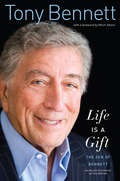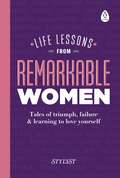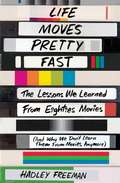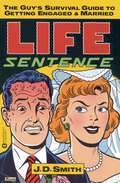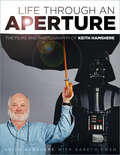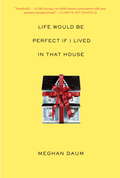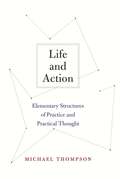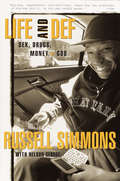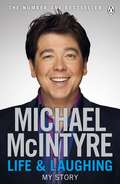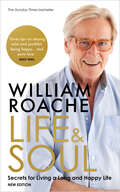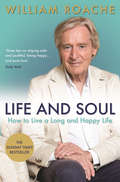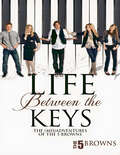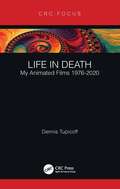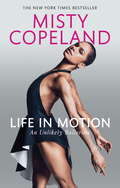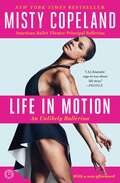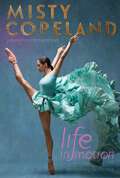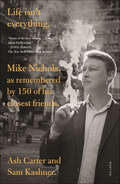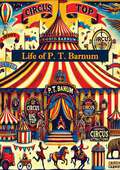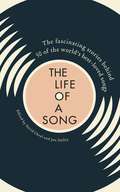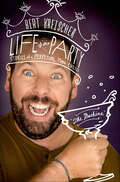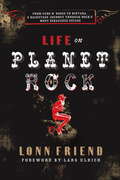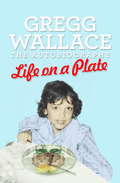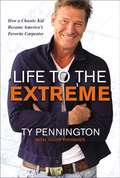- Table View
- List View
Life Is Not a Reality Show: Keeping It Real with the Housewife Who Does It All
by Kyle RichardsIn Life Is Not a Reality Show, breakout star of Bravo’s The Real Housewives of Beverly Hills Kyle Richards reveals everything she’s learned about succeeding without getting stuck up, with insights into everything from keeping a marriage fresh while juggling four kids (with not a nanny in sight) to finding the best beauty steals and home-decorating inspirations.Pop culture fanatics and fans of hip, no-nonsense women’s books from Kelly Cutrone, Bethenny Frankel, and Brandi Glanville will find all they’re looking for and more in Richards’s Life Is Not a Reality Show.
Life Is Not a Stage: From Broadway Baby to a Lovely Lady and Beyond
by Florence Henderson Joel BrokawFor millions of people around the world, Carol Brady is synonymous with motherhood, but growing up as the youngest of ten children in rural Indiana in the aftermath of the Great Depression, Florence Henderson lived a life quite different from that of the quintessential TV mom she later played on television. Florence's father was a dirt-poor tobacco tenant farmer who was nearly fifty years old when he married Florence's twenty-five-year-old mother, and was nearly seventy when Florence was born. Florence's childhood was full of deprivation and abandonment. Her father was an alcoholic at a time when there was no rehab or help for the disease. Their home rarely had electricity or running water. When she was twelve, Florence's mother left the family to work in Cleveland and never returned.Florence opens up about her childhood, as well as the challenges she's faced as an adult, including stage fright, postpartum depression, her extramarital affairs, divorce, her hearing loss, and heart problems. She writes with honesty and wisdom of how her faith and ability to survive has brought her through rough times to a life of profound joy and purpose.
Life Is a Gift: The Zen of Bennett
by Tony BennettA moving and inspiring memoir from one of the greatest musical artists of all time"My given name is Anthony Dominick Benedetto, and Benedetto in Italian means 'the blessed one.' I couldn't say it any better than that."—Tony BennettLegendary singer, artist, and performer, Tony Bennett has been one of the world's most beloved entertainers for more than six decades. From the 78 to the LP to the digital age, Tony has done it all and is still at the top of his game. In decade after decade, this artistic icon—who has won seventeen Grammys, sung for ten presidents, and performed for royalty—has refused to compromise his vision or values. His unwavering commitment to quality has helped him stay true to his classic sound and is the reason his music continues to endure. Mentored by such legends as Duke Ellington, Frank Sinatra, Ella Fitzgerald, and Nat King Cole, Bennett has only gotten better with age, and his popularity continues to grow as each new generation discovers his timeless songs and incredible voice.In this entertaining and thoughtful memoir, a collection of soulful reflections and philosophies from his life and career, Bennett shares stories of friends and family and the essential lessons they have taught him: of the value of hard work and of creating art that continues to inspire; of perseverance and a dedication to excellence; of the necessity of humility, love, respect, and, most important, gratitude. Bennett cherishes the passion and insatiable thirst for knowledge that have shaped his life and made each day a journey of discovery. He pays tribute to all the remarkable talents he has had the honor to work with and to learn from, including Luciano Pavarotti, Judy Garland, Cary Grant, Fred Astaire, Count Basie, Louis Armstrong, Aretha Franklin, Barbra Streisand, Paul McCartney, Amy Winehouse, Willie Nelson, Lady Gaga, David Hockney, and k.d. lang, to name just a few.A magnificent testament to an extraordinary man and his art, and illustrated with Tony Bennett's own beautiful hand-drawn artwork, Life Is a Gift is a work that will captivate, delight, and be cherished by music lovers of all ages.
Life Lessons from Remarkable Women: Tales of Triumph, Failure and Learning to Love Yourself
by Stylist MagazineIf you could share one lesson from your life with every woman, what would it be?Stylist magazine has asked that question of remarkable women from the worlds of entertainment, politics, sport and fashion. With honesty, wit and a serious no-BS attitude, their lessons address the challenges every woman faces today, from climbing the career ladder and finding inner fulfilment, to forging authentic relationships and overcoming life's setbacks.Each of these impressive women, including actress Romola Garai and comedian Francesca Martinez, has a tale to tell and an experience to share. Empowering, engaging and unapologetically impassioned, their incisive observations will make you think, reflect - and kick serious ass. These are life lessons for women, by women.
Life Moves Pretty Fast: The Lessons We Learned from Eighties Movies (and Why We Don't Learn Them from Movies Anymore)
by Hadley FreemanFrom Vogue contributor and Guardian columnist Hadley Freeman, a personalized guide to eighties movies that describes why they changed movie-making forever—featuring exclusive interviews with the producers, directors, writers and stars of the best cult classics.For Hadley Freeman, movies of the 1980s have simply got it all. Comedy in Three Men and a Baby, Hannah and Her Sisters, Ghostbusters, and Back to the Future; all a teenager needs to know in Pretty in Pink, Ferris Bueller’s Day Off, Say Anything, The Breakfast Club, and Mystic Pizza; the ultimate in action from Top Gun, Die Hard, Beverly Hills Cop, and Indiana Jones and the Temple of Doom; love and sex in 9 1/2 Weeks, Splash, About Last Night, The Big Chill, and Bull Durham; and family fun in The Little Mermaid, ET, Big, Parenthood, and Lean On Me. In Life Moves Pretty Fast, Hadley puts her obsessive movie geekery to good use, detailing the decade’s key players, genres, and tropes. She looks back on a cinematic world in which bankers are invariably evil, where children are always wiser than adults, where science is embraced with an intense enthusiasm, and the future viewed with giddy excitement. And, she considers how the changes between movies then and movies today say so much about society’s changing expectations of women, young people, and art—and explains why Pretty in Pink should be put on school syllabuses immediately. From how John Hughes discovered Molly Ringwald, to how the friendship between Dan Aykroyd and John Belushi influenced the evolution of comedy, and how Eddie Murphy made America believe that race can be transcended, this is a “highly personal, witty love letter to eighties movies, but also an intellectually vigorous, well-researched take on the changing times of the film industry” (The Guardian).
Life Sentence: The Guy's Survival Guide to Getting Engaged and Married
by J. D. SmithHandbook to what to expect before, during & after the wedding day.
Life Through an Aperture: The Films and Photography of Keith Hamshere
by Gareth Owen Keith HamshereFor blockbuster photographer Keith Hamshere it was the humble ukulele, given to him for his ninth birthday, that piqued his interest in the entertainment industry, leading to a long and impressive career in front of and behind the camera.Starting out in the late 1950s as a child actor, Keith decided to add another string to his bow, developing his interest in photography and becoming a society photographer at the heart of Swinging London.Keith’s big break came in the mid 1960s, when unit photographer Johnny Jay began working on a new film directed by Stanley Kubrick. Recalling Keith’s fascination with photography and his growing popularity, Johnny asked him if he would be interested in helping out on 2001: A Space Odyssey. Keith did not need to think twice about his answer.Following on from his stellar work on 2001, Keith went on to become an established stills photographer and amassed an impressive filmography, working on films such as Battle of Britain and Superman II before embarking on the first of eight James Bond assignments: The Spy Who Loved Me. Along with his Bond films, Keith also worked on other legendary franchises, including Indiana Jones and the Temple of Doom and the three Star Wars prequels, among many others.For more than five decades, Keith played a key role in creating some of the most iconic images from some of the biggest movies ever made. In Life Through an Aperture, he shares his fascinating tales of rubbing shoulders with the biggest names in Hollywood, alongside his incredible images.
Life Would Be Perfect If I Lived in That House
by Meghan DaumFrom the acclaimed author and columnist: a laugh-out-loud journey into the world of real estate--the true story of one woman's "imperfect life lived among imperfect houses" and her quest for the four perfect walls to call home.After an itinerant suburban childhood and countless moves as a grown-up--from New York City to Lincoln, Nebraska; from the Midwest to the West Coast and back--Meghan Daum was living in Los Angeles, single and in her mid-thirties, and devoting obscene amounts of time not to her writing career or her dating life but to the pursuit of property: scouring Craigslist, visiting open houses, fantasizing about finding the right place for the right price. Finally, near the height of the real estate bubble, she succumbed, depleting her life's savings to buy a 900-square-foot bungalow, with a garage that "bore a close resemblance to the ruins of Pompeii" and plumbing that "dated back to the Coolidge administration." From her mother's decorating manias to her own "hidden room" dreams, Daum explores the perils and pleasures of believing that only a house can make you whole. With delicious wit and a keen eye for the absurd, she has given us a pitch-perfect, irresistible tale of playing a lifelong game of house.From the Hardcover edition.
Life and Action: Elementary Structures of Practice and Practical Thought
by Michael ThompsonIn a book as entertaining as it is enlightening, Kristin Thompson offers the first in-depth analysis of Hollywood's storytelling techniques and how they are used to make complex, easily comprehensible, entertaining films. She also takes on the myth that modern Hollywood films are based on a narrative system radically different from the one in use during the Golden Age of the studio system. Drawing on a wide range of films from the 1920s to the 1990s--from Keaton's Our Hospitality to Casablanca to Terminator 2--Thompson explains such staples of narrative as the goal-oriented protagonist, the double plot-line, and dialogue hooks. She domonstrates that the "three-act structure," a concept widely used by practitioners and media commentators, fails to explain how Hollywood stories are put together. Thompson then demonstrates in detail how classical narrative techniques work in ten box-office and critical successes made since the New Hollywood began in the 1970s: Tootsie, Back to the Future, The Silence of the Lambs, Groundhog Day, Desperately Seeking Susan, Amadeus, The Hunt for Red October, Parenthood, Alien, and Hannah and Her Sisters. In passing, she suggests reasons for the apparent slump in quality in Hollywood films of the 1990s. The results will be of interest to movie fans, scholars, and film practitioners alike.
Life and Def
by Russell SimmonsRussell Simmons, the original and eternal hip-hop mogul, is one of the most innovative and influential figures in modern American business and culture. When no one outside of inner-city New York had even heard of hip-hop, Simmons saw the seeds of a global force that would change the way people talk, dress, listen to music, and choose the heroes they hang on their walls. Today, he oversees a sprawling, multimillion-dollar empire of culture-defining businesses in everything from music to fashion, advertising to film, and media to visual art. At the same time he's broadened his interests and influence and pushed hip-hop to new plateaus of power and relevance. Life and Def is a one-of-a-kind tale that interweaves the remarkable journey of Russell Simmons with the story of the culture he's transformed and been transformed by. In his own brash, compelling voice, Simmons chronicles his numerous business successes and occasional failures. He tells the story of the founding of the legendary Def Jam Records, whose roster stretches from original rap icons like L.L. Cool J, Public Enemy, and the Beastie Boys to today's top stars, including Jay-Z and DMX. He traces the launching of Def Comedy Jam, the long-running hit television series that introduced a new generation of black comedic stars to America, from Martin Lawrence and Bill Bellamy to Bernie Mac and Chris Rock. He spins hilarious tales of his adventures in Hollywood, where he's produced hit movies like Eddie Murphy's The Nutty Professor and worked with quirky geniuses like Abel Ferrara. He also tells the story of Phat Farm, the wildly successful pioneering urban clothing label whose origins lay in Russell's longtime fascination with fashion (and fashion models).Simmons's story is also one of personal transformation, from the driven man who in the heady days of early success indulged himself with drugs, sex, and world-class decadence to the husband and father he is today, a man who has found meaning in activism, philanthropy, and spiritual practice while never losing his passion for the social, political, artistic, and commercial potential of hip-hop.Through it all he relates telling anecdotes about the characters he's dealt with: models and gangsters, street poets and gurus, and major players like Donald Trump, Sean Combs, Jon Peters, and Tupac Shakur. Full of advice, opinions, and behind-the-scenes scoop, Life and Def is the story of the quintessential hip-hop life.From the Hardcover edition.
Life and Laughing: The bestselling first official autobiography from Britain’s biggest comedy star
by Michael McIntyreDiscover the real Michael McIntyre through his remarkable and hilarious journey to comedy stardom in his first official autobiography'This book showed me the REAL Michael McIntyre' 5***** READER REVIEW'It made me laugh, cry, laugh, laugh and laugh some more' 5***** READER REVIEW'Simply is a must read . . . His story is fascinating' 5***** READER REVIEW'To anyone who loves Michael McIntyre - you will not be disappointed!' 5***** READER REVIEWTHE NO. 1 BESTSELLER_______Michael McIntyre is Britain's biggest comedy star. But how did he get there? Michael reveals all in his remarkably honest and hilarious autobiography, Life and Laughing.From his showbiz roots to his appalling attempts to attract the opposite sex, his fish-out-of-water move from public to state school, and his astonishing journey from selling just one ticket at the Edinburgh Festival to selling half a million tickets on tour.Filled with riveting anecdotes and poignant lessons, Life and Laughing is the unmissable story of Britain's biggest comedian's rise to stardom.Above all, it's very, very funny.
Life and Soul (New Edition): Secrets for Living a Long and Happy Life
by William RoacheA special edition of William Roache&’s inspiring guide, sharing his philosophy, practical tips, and life lessons for leading a happy, healthy life.THE SUNDAY TIMES BESTSELLER—NOW WITH BRAND-NEW CONTENT. Discover the secret to a balanced, happy life as William Roache shares the lessons, wisdom, and practices that have helped him overcome difficult times. &“I have nothing but respect for this man of peace and integrity.&”—Sir Cliff Richard &“An amazing man.&”—Lorraine Kelly &“A thoroughly good soul.&”—Gloria Hunniford William Roache is known worldwide for his portrayal of Ken Barlow in Coronation Street. Now aged 90, he still appears regularly in the show and rebuffs any notion that age brings decline. In this special edition of Life and Soul, William reveals his wisdom on achieving a healthy, happy mindset and looks back over his 90 years, sharing his philosophy for living a full, enriching life. In a brand-new chapter, he talks about his experience during the pandemic and how he maintained his positivity and resilience throughout. William speaks openly and honestly about how his lifestyle gave him the strength to live through the sudden deaths of his wife Sara, his oldest daughter, and his close friend Anne Kirkbride. He reveals the life choices that form the basis for his wellbeing: from the meditation techniques that have kept him going through the darkest days, to lessons he has learned about the power of love, kindness, and positive thinking.William's personal philosophy will inspire you to live a rich and rewarding life, and the lessons he has learned along the way will help you achieve happiness, health, and longevity.
Life and Soul: How to Live a Long and Healthy Life
by William RoacheWilliam Roache is known worldwide for his portrayal of Ken Barlow in Coronation Street. Now aged 86, he still appears regularly in the show and rebuffs any notion that age brings decline.In Life and Soul, William shares his strategy for keeping fit and healthy, for maintaining his youthful looks and for coping with life’s most challenging times. He talks openly about the life choices that form the basis for his well-being: from the meditation techniques that have kept him going through the darkest days, to lessons he has learned about the power of love, kindness and positive thinking.William speaks openly and honestly about how his lifestyle gave him the strength to live through recent events, including the deaths of his wife Sara, and close friend Anne Kirkbride, as well as a harrowing court case.William reveals his common-sense approach to diet and exercise that keeps him t, healthy and looking 10 years younger than his age. He talks about the support of his family and friends, and explains why he believes that we must accept and embrace hard times – and how we can become stronger as a result. He now shares his personal philosophy for living a rich and rewarding life, and the lessons he has learned along the way – lessons he hopes will help others to achieve a long, happy and healthy life too.
Life between the Keys: The Misadventures of The 5 Browns
by Aaron GriegoThe 5 Browns are a classical music ensemble of three sisters and two brothers— Desirae, Deondra, Melody, Gregory, and Ryan— who perform and record works on five grand pianos. They were the first family of five siblings to enroll simultaneously at New York' s performing arts conservatory, Juilliard, in the school' s 100-year history. With sold-out concerts and screaming fans, The 5 Browns have redefined what it means to be classical musicians. Featuring personal essays from all five siblings, Life between the Keys chronicles their journey from obscurity to stardom, from childhood piano competitions to cutthroat practice rooms at Juilliard and wide acclaim on the international stage. In their own words, these charming, warm, and funny siblings reveal their impressions and memories of living a musical life.
Life in Death: My Animated Films 1976-2020
by Dennis TupicoffDeath—the very word is resonant with emotion, imagery, and meaning. It is the ultimate life-event that all living things will eventually experience; as such, it comes as no surprise that death is often a popular theme of literature, art, games, cinema, music, and even animation. Dennis Tupicoff, world-renowned animator, writer, and producer, is an expert on the narrative application of death in animation. Take a journey with Tupicoff as he goes in-depth into the many themes, associations, and practices found in film and especially animation. Life in Death: My Animated Films 1976–2020 explores death as it relates to experience, storytelling, theory, and narrative. The examples in the very readable text are organized into three broad categories: cartoon, documentary, and hybrids of various types. KEY FEATURES Explores death as a narrative theme within cinema and animation Biographical insight into Dennis Tupicoff’s works and how the subject of death impacted these completed award-winning films Special online access to Dennis Tupicoff’s animated works In-depth exploration into ten of Dennis Tupicoff’s most influential animations
Life in Motion: An Unlikely Ballerina
by Misty CopelandWhen Misty Copeland first placed her hands on the ballet barre at an after-school community centre, no one expected the undersized, underprivileged and anxious thirteen-year-old to become one of America's most groundbreaking dancers. A true prodigy, she was attempting in months roles that take most dancers years to master. But when Misty became caught between the control and comfort she found in the world of ballet and the harsh realities of her own life, she had to choose to embrace both her identity and her dreams, and find the courage to be one of a kind.In this instant New York Times bestseller, Misty Copeland tells the story of her historic journey to become the first African-American principal ballerina at the prestigious American Ballet Theatre. With an insider's passion, Misty opens a window into the life of an artist who lives life centre stage, from behind the scenes at her first classes to her triumphant roles in some of the world's most iconic ballets. Life in Motion is a story of passion, identity and grace for anyone who has dared to dream of a different life.
Life in Motion: An Unlikely Ballerina
by Misty CopelandA bestselling and prizewinning memoir by African American ballerina Misty Copeland, Life in Motion is the vividly told story of her journey to the world-class American Ballet Theatre—and delves into the harrowing family conflicts that nearly drove her away from ballet as a thirteen-year-old prodigy.Determination meets dance in this New York Times bestselling memoir by the history-making ballerina Misty Copeland, recounting the story of her journey to become the first African-American principal ballerina at the prestigious American Ballet Theatre. When she first placed her hands on the barre at an after-school community center, no one expected the undersized, underprivileged, and anxious thirteen-year-old to become one of America&’s most groundbreaking dancers . A true prodigy, she was attempting in months roles that take most dancers years to master. But when Misty became caught between the control and comfort she found in the world of ballet and the harsh realities of her own life, she had to choose to embrace both her identity and her dreams, and find the courage to be one of a kind. With an insider&’s passion, Misty opens a window into the life of an artist who lives life center stage, from behind the scenes at her first classes to her triumphant roles in some of the world&’s most iconic ballets. A sensational memoir as &“sensitive&” and &“clear-eyed&” (The Washington Post) as her dancing, Life in Motion is a story of passion, identity and grace for anyone who has dared to dream of a different life.
Life in Motion: An Unlikely Ballerina Young Readers Edition
by Misty CopelandDetermination meets dance in this middle grade adaptation of the New York Times bestselling memoir by the first African-American principal dancer in American Ballet Theatre history, Misty Copeland.As the first African-American principal dancer at the American Ballet Theatre, Misty Copeland has been breaking down all kinds of barriers in the world of dance. But when she first started dancing--at the late age of thirteen--no one would have guessed the shy, underprivileged girl would one day make history in her field. Her road to excellence was not easy--a chaotic home life, with several siblings and a single mother, was a stark contrast to the control and comfort she found on stage. And when her home life and incredible dance promise begin to clash, Misty had to learn to stand up for herself and navigate a complex relationship with her mother, while pursuing her ballet dreams. Life in Motion is a story for all the kids who dare to be different, dream bigger, and want to break stereotypes in whatever they do.
Life isn't everything: Mike Nichols, as remembered by 150 of his closest friends.
by Sam Kashner Ash CarterAn up close and personal portrait of a legendary filmmaker, theater director, and comedian, drawing on candid conversations with his closest friends in show business and the arts—from Dustin Hoffman and Meryl Streep to Natalie Portman and Lorne Michaels.The work of Mike Nichols pervades American cultural consciousness—from The Graduate and Who's Afraid of Virginia Woolf? to Angels in America, The Birdcage, Working Girl, and Primary Colors, not to mention his string of hit plays, including Barefoot in the Park and The Odd Couple. If that weren’t enough, he was also one half of the timelessly funny duo Nichols & May, as well as a founding member of the original improv troupe. Over a career that spanned half a century, Mike Nichols changed Hollywood, Broadway, and comedy forever. Most fans, however, know very little of the person behind it all. Since he never wrote his memoirs, and seldom appeared on television, they have very little sense of his searching intellect or his devastating wit. They don't know that Nichols, the great American director, was born Mikail Igor Peschkowsky, in Berlin, and came to this country, speaking no English, to escape the Nazis. They don't know that Nichols was at one time a solitary psychology student, or that a childhood illness caused permanent, life-altering side effects. They don't know that he withdrew into a debilitating depression before he "finally got it right," in his words, by marrying Diane Sawyer.Here, for the first time, Ash Carter and Sam Kashner offer an intimate look behind the scenes of Nichols' life, as told by the stars, moguls, playwrights, producers, comics and crewmembers who stayed loyal to Nichols for years. Life Isn't Everything is a mosaic portrait of a brilliant and original director known for his uncommon charm, wit, vitality, and genius for friendship, this volume is also a snapshot of what it meant to be living, loving, and making art in the 20th century.
Life of P. T. Barnum, Written By Himself; Including His Golden Rules For Money-Making [Expanded 1888 edition]
by P. T. BarnumStep into the extraordinary life of one of America's most iconic showmen with P.T. Barnum's captivating autobiography, "Life of P.T. Barnum, Written By Himself; Including His Golden Rules For Money-Making." This remarkable memoir provides an intimate look at the life and career of Phineas Taylor Barnum, the mastermind behind "The Greatest Show on Earth," and offers invaluable insights into his philosophy on success and wealth.In his own words, P.T. Barnum recounts his journey from humble beginnings to becoming a legendary entrepreneur and master of entertainment. With wit, charm, and candor, Barnum shares the highs and lows of his career, from his early ventures and failures to his monumental successes in the world of circuses, museums, and public spectacles. His narrative is filled with colorful anecdotes, daring exploits, and behind-the-scenes stories that bring to life the vibrant world of 19th-century entertainment.Beyond the enthralling tales of his adventures, Barnum's autobiography includes his "Golden Rules For Money-Making," a set of practical and timeless principles for achieving financial success. These rules reflect Barnum's shrewd business acumen and his belief in the value of hard work, creativity, and ethical conduct. Readers will find inspiration and guidance in Barnum's advice on risk-taking, innovation, and maintaining a positive reputation."Life of P.T. Barnum" is not just a biography; it is a treasure trove of wisdom and a testament to the power of perseverance and ingenuity. Barnum's story is a celebration of the American spirit, highlighting the possibilities that arise from ambition, resilience, and a relentless pursuit of one's dreams.This book is an essential read for entrepreneurs, history enthusiasts, and anyone fascinated by the life of a man who transformed the entertainment industry. "Life of P.T. Barnum, Written By Himself" offers a unique blend of autobiography, business manual, and motivational guide, ensuring its place as a timeless classic in the literature of success.Join P.T. Barnum on a journey through his incredible life, and discover the principles that helped him build an empire. This engaging and insightful autobiography will inspire you to think big, embrace opportunities, and create your own path to success.
Life of a Song: The fascinating stories behind 50 of the worlds best-loved songs
by David Cheal Jan DalleyWho knew that Paul McCartney originally referred to Yesterday as 'Scrambled Eggs' because he couldn't think of any lyrics for his heart-breaking tune? Or that Patti LaBelle didn't know what 'Voulez-vous couches avec moi ce soir?' actually meant?These and countless other fascinating back stories of some of our best-known and best-loved songs fill this book, a collection of the highly successful weekly The Life of a Song columns that appear in the FT Weekend every Saturday. Each 600-word piece gives a mini-biography of a single song, from its earliest form (often a spiritual, or a jazz number), through the various covers and changes, often morphing from one genre to another, always focusing on the 'biography' of the song itself while including the many famous artists who have performed or recorded it.The selection covers a wide spectrum of the songs we all know and love - rock, pop, folk, jazz and more. Each piece is pithy, knowledgeable, entertaining, full of anecdotes and surprises. They combine deep musical knowledge with the vivid background of the performers and musicians, and of course the often intriguing social and political background against which the songs were created.
Life of the Party: Stories of a Perpetual Man-Child
by Bert KreischerA collection of outrageous stories by the standup comic, TV host, and inspiration for the movie National Lampoon’s Van Wilder.“Bert Kresicher is as fearless on the page as he is on the stage. Bert admits things in Life of the Party that most of us wouldn’t even admit to ourselves. Open to page one and let Bert Kreischer take you on a magical ride.” —Mick Foley, #1 New York Times–bestselling author of Foley Is GoodBert Kreischer doesn’t know how to say “no.” If he did, he wouldn’t have gotten himself mixed up with a group of Russian mobsters on a class trip to Moscow, earning him his nickname, “The Machine.” He wouldn’t have wrestled with a bear or swum with sharks on national television. He wouldn’t have (possibly) smoked PCP with a star of Saturday Night Live. And he wouldn’t have been named the Number One Partier in the Nation by Rolling Stone, inspired the movie National Lampoon’s Van Wilder, or have become one of the most in-demand touring comedians in the world, performing to sellout crowds across the country.The stories Kreischer shares in Life of the Party are a guidebook on how not to grow up. From his fraternity days at Florida State University to his rise as a stand-up to his marriage and first brushes with fatherhood, Kreischer shows you a path that may not lead you to maturity or personal growth. But it will lead you to a shitload of fun.“[Kreischer’s] affability and self-deprecation only lead to his charm, and the result is a genuinely hilarious look at life in the fast lane.” —Publishers Weekly
Life on Planet Rock
by Lonn FriendFor fans of heavy metal music, RIP magazine was a cultural touchstone, every bit as crucial in its day as Kerrang, NME or Rolling Stone. Lonn Friend, RIP's legendary editor, helped launch and revive the careers of innumerable acts - including Guns n' Roses, Metallica and Pearl Jam - and created some of the most enduring rock journalism of the decade, rivaling the best work of Lester Bangs and Cameron Crowe. In Life on Planet Rock, Friend describes in lucid and lurid detail how he became the Zelig-like chronicler of the biggest musical moments of the 80s and 90s, providing revealing portraits of artists as varied as Gene Simmons, Alice Cooper, Axl Rose, Jon Bon Jovi, Kurt Cobain, and Steven Tyler, among others. A candid and humorous memoir to appeal to fans of Motley Crue's The Dirt and Seb Hunter's Hell Bent For Leather, Life on Planet Rock is a wormhole back to a fast-moving time in music, filled with Dionysian excess and bombastic egos, told as only someone who was there through it all could tell it.
Life on a Plate: The Autobiography
by Gregg WallaceThe star presenter of BBC's MASTERCHEF tells his story for the first time.Gregg Wallace, star presenter of BBC's MASTERCHEF, restaurateur and expert on all things pudding, shares his story for the first time. After leaving school at 14, he started his career as a greengrocer at the New Covent Garden market and went on to create his multi-million pound fruit and veg business a decade later. A star slot on BBC VEG TALK,and an award-winning television programme followed and, in 2005, the chance to front MASTERCHEF, a show that has drawn in over 4.5 million viewers and produced some of the nation's best up-and-coming chefs. He has since opened two restaurants, Wallace & Co and Gregg's Table, penned numerous cookery books, and has written for the national and trade press. In this, his first memoir, Gregg tells how his early passion for food growing up in Peckham, south London, led to a world of Michelin star restaurants, celebrity chefs and a mission to save Britain's produce - and in an extraordinary turn with more than a few life-changing hurdles - brought him back to his roots.
Life to the Extreme: How a Chaotic Kid Became America’s Favorite Carpenter
by Ty PenningtonTy Pennington shares stories from his life and offers a behind-the-scenes look at your favorite home shows!As a kid, Ty Pennington had too much energy. He was chaotic, bouncing off the walls, and on a first-name basis with the local emergency room staff. Back then there wasn't public awareness of attention deficit disorder yet. People just thought Ty was rambunctious. A trouble maker. What do you do with a kid who just can't sit still? Who can't focus?But Ty discovered something amazing when he was just a boy: he felt focused when he was building something. He discovered that he loved to work with his hands - to use tools and be creative. He loved to try new things, build and design new things.In Life to the Extreme Ty shares his remarkable life story. In his characteristic humorous style, he takes you racing through his life with ADHD-infused diversions that will make you laugh out loud. He shares about how he was diagnosed with ADHD in college, and what it has meant to be an advocate for ADHD awareness. He shares about his start as a model and carpenter, and his eventual move to television where he starred in the hit shows Extreme Makeover: Home Edition and Trading Spaces.Life to the Extreme will inspire you. Ty's boundless energy and his sense of humor are infectious. You'll laugh. You might cry a little. And you'll definitely be inspired to change the lives of those around you.
